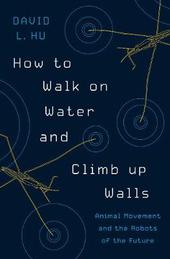
|
How to Walk on Water and Climb up Walls: Animal Movement and the Robots of the Future
Hardback
Main Details
| Title |
How to Walk on Water and Climb up Walls: Animal Movement and the Robots of the Future
|
| Authors and Contributors |
By (author) David Hu
|
| Physical Properties |
| Format:Hardback | | Pages:240 | | Dimensions(mm): Height 235,Width 155 |
|
| Category/Genre | Zoology and animal sciences
Animal physiology
Mechanical engineering and materials |
|---|
| ISBN/Barcode |
9780691169866
|
| Classifications | Dewey:591.57 |
|---|
| Audience | |
|---|
| Illustrations |
12 color + 33 b/w illus.
|
|
Publishing Details |
| Publisher |
Princeton University Press
|
| Imprint |
Princeton University Press
|
| Publication Date |
13 November 2018 |
| Publication Country |
United States
|
Description
Discovering the secrets of animal movement and what they can teach us Insects walk on water, snakes slither, and fish swim. Animals move with astounding grace, speed, and versatility: how do they do it, and what can we learn from them? In How to Walk on Water and Climb up Walls, David Hu takes readers on an accessible, wondrous journey into the
Author Biography
David L. Hu is associate professor of mechanical engineering and biology and adjunct professor of physics at Georgia Institute of Technology. He lives in Atlanta.
Reviews"Co-Winner of the AIP Science Communication Book Award, American Institute of Physics" "Longlisted for the Young Adult Science Book Award, AAAS/Subaru SB&F Prize for Excellence in Science Books" "Finalist for the AAAS/Subaru SB&F Prizes for Excellence in Science Books, Young Adult Science Books" "One of Inverse's Best Science Books of 2018" "In How to Walk on Water and Climb up Walls . . . [Dr. Hu] describes both the silliness and profundity of his brand of research. . . . He refers to the urethra as a pee-pee pipe. And he corrects his son when he brags that only he, not his sister, has a pee-pee pipe. . . . Once older, his children may never forgive him for this book. But middle school science teachers and nerds everywhere will thank him."---James Gorman, New York Times "[How to Walk on Water and Climb Up Walls] answers questions you probably won't realize you even had, but they're questions with serious answers that span the worlds of physics, fluid mechanics, and biology. Throughout the book, Hu demonstrates the extraordinary value day-to-day curiosity brings to science."---Christopher Intagliata, Science Friday "[An] engrossing tour of faunal motion."---Barbara Kiser, Nature "Hu distills the complex science that demystifies how flying snakes glide and sharks make for remarkably efficient swimmers. Breaking down these concepts is not easy and Hu is up to the task, backing up the science with impassioned explainers."---Ronak Gupta, The Wire "Roboticists tasked with designing the machines of tomorrow are inspired by the spectacular blueprints created by nature. In How to Walk on Water and Climb up Walls, David Hu dives into these all-natural plans and explains why they're so useful to robot design. The way a snake slithers or a dog shakes off water, it seems, are far too valuable to take for granted."---Sarah Sloat, Inverse "A fascinating book."---Dominic Lenton, Engineering and Technology "This highly accessible and exciting book is a quick, enjoyable adventure."---Grrl Scientist, Forbes "Hu masterfully explains scientific revelations such as how insects walk on water, snakes slither and mosquitos survive rainstorms using rich tales of discovery and analogies that brim with satisfying 'aha' moments."---Natalie Parletta, Cosmos "Hu weaves examples into a story seamlessly and intelligibly. . . . This book is a lesson in keeping an open mind to how strange the world is."---Laura Mast, Massive Science "Hu's writing is chatty, entertaining, gracious, and very clear."---Ernest Davis, SIAM News "Through stories about researchers he has interacted with over the course of his career and a biographical view of his own projects, Hu shows readers that we still have a lot to learn about animal locomotion."---Marc S. Lavine, Science "A joyous read for curious minds."---Farid Pazhoohi, Canadian Field Naturalist
|